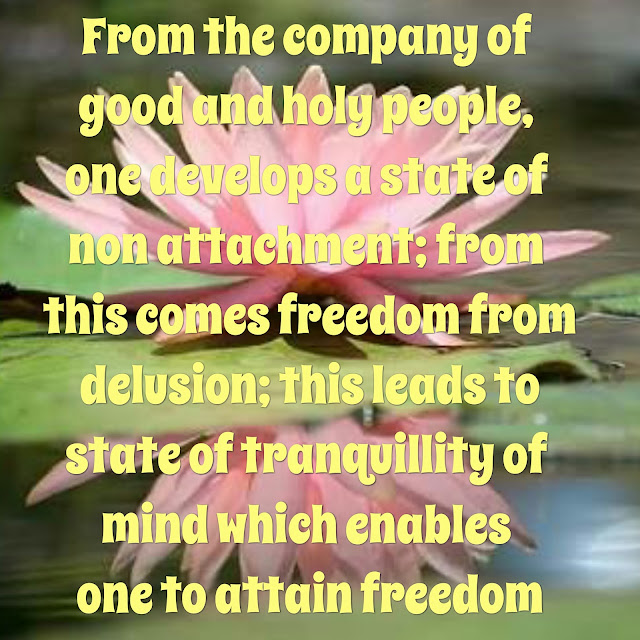सत्सङ्गत्वे निस्सङ्गत्वं
निस्सङ्गत्वे निर्मोहत्वम् ।
निर्मोहत्वे निश्चलतत्त्वं
निश्चलतत्त्वे जीवन्मुक्तिः ॥ ९॥
satsaNgatve nissN^gatvaM
nissaNgatve nirmohatvam.h .
nirmohatve nishchalatattvaM
nishcalatattve jiivanmuktiH .. (9)
nissaNgatve nirmohatvam.h .
nirmohatve nishchalatattvaM
nishcalatattve jiivanmuktiH .. (9)
(satsaN^gatve = in good company;
nissaN^gatvaM = non-attachment / detachment; nirmohatvaM = non-infatuated state
/ clearheadedness; nishchalatattvaM = tranquility / imperturbability;
jiivanmuktiH = salvation + freedom from bondage of birth.)
(satsaN^gatve nissaN^gatvaM = Through
satsanga (company of good and holy people), non - attachment (is achieved);
nissaN^gatve nirmohatvam.h = by non-attachment, non- infatuated state;
nirmohatve nishchalatattvaM = through non- infatuated state, tranquility;
nishchalatattve jiivanmuktiH = from tranquility, freedom from bondage of
birth.)
Sri Sankara here gives us a ladder to
climb up to the level of salvation. The first step is satsanga: the company of
holy people, saints, good men and women. This is the basis of all further
steps. The flow of knowledge is from the guru to disciples. This has been the
method of transmission of this knowledge through generations, through
centuries.
It
is a well-known fact that good character is developed from the company of good
people and degradation is likely to follow the company of the wicked. Hence the
spiritual aspirants desirous of God realization should attempt to keep only the
company of really good people; if available, men who have seen God. Satsanga
helps them know which is real and which is transitory; which leads to God and
which leads away. Equipped thus with true knowledge, the aspirant slowly
develops non-attachment to things of the world. The Gita lays great stress on
non–attachment; It is termed Anasakti Yoga. This attitude of renunciation of
worldly pleasures and charms is required for further progress. The spiritual
aspirant who is non-attached slowly gets free from delusion. The Maya of the
world fails to mislead such a sadhaka. When he meditates on the Lord with the
mind thus purified, he is sure to reach a state of tranquility. The tranquil
mind soon realizes Truth. The Yogi now attains freedom. Freedom from the chain
of birth and death; freedom from ignorance, misery, transitory nature of the
world. This was the aim of his sadhana.
The ladder thus shown by Sri Sankara is
similar to the one given in the Gita: In Gita, Sri Krishna shows a ladder which
goes down – to degradation:
“Dhyaayato vishayaan pumsah
sangasteshuupajayate Sangaat samjaayate kamah kamat krodhobhijayate Krodhaat
bhavati sammohah sammohaat smruti vibhramah Smrutibhramshaat buddhi naasho
buddhinaashaat pranashyati.” - (Bhagavat Gita Chapter 2, slaokas 62 and 63)
“Brooding on the objects of senses, man
develops attachment to them; from attachment comes desire; from desire anger
sprouts forth. From anger proceeds delusion; from delusion, confused memory;
from confused memory the ruin of reason; due to the ruin of reason he
perishes.”
He
who is dead as it were when alive, that is to say, as desire-less as a corpse,
becomes competent for Brahma–jnanam ie knowledge of the supreme.

No comments:
Post a Comment